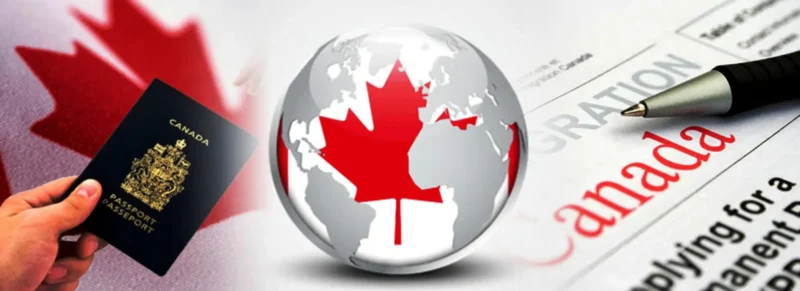Canada’s New Immigration Rules: What Changed in 2025
Immigration to Canada scene is undergoing a notable shift in 2025. The government has introduced fresh rules across temporary and permanent residency streams, all aimed at balancing population growth, curbing strain on infrastructure, and prioritizing strategic economic needs. Immigration to Canada is becoming more structured and intentional.
The Big Picture: A Strategic Shift
The Canadian government’s new approach centers on one clear goal: reducing the share of temporary residents to 5% of the total population by the end of 2026. This represents a fundamental shift from the previous open-door approach to a more controlled, targeted system that prioritizes integration over sheer numbers. This focus on Immigration to Canada signifies a shift towards ensuring that newcomers can thrive in their new environment.
What makes this transformation particularly interesting is Canada’s focus on “home-grown” talent. More than 40% of anticipated permanent resident admissions in 2025 will be from those who are already in Canada as temporary residents. This isn’t just a policy tweak, it’s a complete reimagining of how Canada builds its future workforce. Here’s a breakdown of what’s changing:
Temporary Residence: New Caps and Enhanced Powers
The 5% Cap Revolution
For the first time in Canadian immigration history, temporary residents including international students and foreign workers will be capped at 5% of the total population. Currently sitting at around 6.2%, this reduction means tens of thousands fewer temporary residents will be admitted in the coming years.
This cap isn’t just a number on paper. It’s forcing institutions, employers, and prospective immigrants to compete more intensely for limited spots. Universities that previously relied heavily on international student tuition revenue are now scrambling to adjust their business models, while employers must think more strategically about which foreign workers they truly need.
Strengthened Officer Authority
Immigration officers now wield significantly more power to immediately cancel study and work permits for individuals who misuse the system. This represents a shift from bureaucratic processes to real-time enforcement, giving officers the authority to act swiftly when they detect fraud or non-compliance, such measures are essential for maintaining the integrity of the Immigration to Canada process.
The enhanced powers extend beyond simple cancellations. Officers can now question individuals more extensively and require additional documentation at their discretion, creating a more dynamic but potentially unpredictable environment for temporary residents.
Stricter Student Program Controls
The international student program has undergone particularly rigorous reforms. New compliance measures target exploitation within the system, addressing concerns about diploma mills and institutions that prioritized profit over educational quality. Students now face heightened scrutiny throughout their stay, not just at entry.
Permanent Residence: Quality Over Quantity
Reduced Targets with Strategic Focus
The 2025 Immigration to Canada Levels Plan sets notably lower permanent residence targets, marking a departure from the growth-at-all-costs mentality of previous years. These reductions aren’t arbitrary cuts, they’re strategic realignments focusing on economic streams, particularly healthcare and skilled trades where Canada faces critical shortages.
The new targets prioritize sustainable integration over impressive headlines. By admitting fewer people but ensuring they’re better positioned for success, Canada aims to improve long-term outcomes for both newcomers and existing residents.
The “Already Here” Advantage
Perhaps the most significant philosophical shift is Canada’s emphasis on converting temporary residents to permanent status. Research consistently shows that newcomers with Canadian experience achieve better long-term success, and the government is acting on this evidence.
This new emphasis on converting temporary residents to permanent status is a key strategy in the Immigration to Canada framework. This creates a new immigration pathway that essentially functions as an extended trial period. International students and foreign workers can prove their ability to integrate and contribute before gaining permanent status, reducing the uncertainty that traditionally accompanies immigration decisions.
New Refugee Pathway
A groundbreaking permanent residency pathway launching by the end of 2025 will target skilled refugees and displaced persons specifically for roles in healthcare, education, and trades. This initiative addresses both humanitarian obligations and economic needs, creating win-win opportunities for Canada and displaced professionals worldwide.
Express Entry: The Merit-Based Revolution
Goodbye to Job Offer Points
The most dramatic change to Express Entry came on March 25, 2025, when Canada removed job offer points from the Comprehensive Ranking System for all current and future candidates. This eliminated up to 200 points that candidates could previously earn through Labour Market Impact Assessment (LMIA)-supported job offers.
This change fundamentally alters the Express Entry terrain. Previously, candidates with job offers had significant advantages, sometimes bypassing more qualified applicants who lacked Canadian employment connections. Now, the system truly evaluates candidates based on their overall merit, education, language skills, work experience, and age rather than their ability to secure a job offer.
The removal affects all types of job offers, from senior management positions that previously earned 200 points to other skilled positions worth 50 points. Current Express Entry candidates don’t need to contact Immigration, Refugees and Citizenship Canada (IRCC) to adjust their scores, the system updated automatically.
Enhanced Francophone Immigration
Canada is doubling down on French-speaking immigration with increased targets and new category-based Express Entry draws specifically for French speakers. This reflects Canada’s commitment to supporting its francophone communities while recognizing that bilingual immigrants often integrate more successfully.
New pilot programs are being developed to attract French-speaking professionals, particularly in sectors where language skills provide added value, such as healthcare, education, and customer service.
Family and Work Permit Changes
Restricted Family Open Work Permits
Starting January 21, 2025, only spouses of certain international students and foreign workers can apply for family open work permits. Family open work permits are now limited to spouses of international students enrolled in specific programs and foreign workers in designated occupations, particularly those in natural and applied sciences.
These restrictions will affect how families plan their Immigration to Canada journey. Many families previously relied on one spouse studying while the other worked to support their Canadian transition. Now, only select programs and occupations qualify for spousal work authorization, requiring more careful planning and potentially longer separation periods.
Maintained Status Rule Changes
The maintained status system underwent major reforms on May 28, 2025, preventing individuals from submitting multiple applications to extend their stay while on maintained status. This closes a loophole that some used to remain in Canada indefinitely by repeatedly applying for different permits or extensions.
Under the new rules, if an application is refused or found inadmissible, individuals cannot immediately submit another application while claiming maintained status. This forces more decisive action and prevents the system from being used as a de facto permanent residence pathway.
Regional and Specialized Programs
Enhanced Caregiver Pathways
Canada is revolutionizing its approach to caregiver immigration with enhanced pathways that may offer permanent residence upon arrival rather than requiring years of temporary work. However, the rollout hasn’t been smooth. The March 31, 2025 launch quickly became overwhelmed, with application systems crashing due to high demand and limited spots.
Despite technical challenges, these programs represent a significant improvement for caregivers, traditionally one of the most vulnerable categories of temporary workers. The new pathways recognize the essential nature of care work and provide more direct routes to permanent status.
Rural Community Focus
The Rural Community Immigration Pilot continues expanding, recognizing that smaller communities often struggle to attract newcomers through traditional programs. These initiatives allow rural communities to sponsor immigrants directly, creating more dispersed settlement patterns and supporting economic development outside major urban centers.
Restricted Flagpoling
“Flagpoling” refers to the practice of leaving and re-entering Canada at a port of entry to apply for work or study permits, it is now restricted. This change forces more applicants to use regular processing channels, reducing border congestion but potentially creating longer processing times for permit applications.
Citizenship and Long-term Changes
Second-Generation Citizenship Reform
Bill C-71 introduces significant changes to second-generation citizenship rules by replacing the first-generation cut-off with a new “substantial connection” test. This affects children born abroad to Canadian citizens, potentially expanding citizenship eligibility while ensuring meaningful connections to Canada.
The substantial connection test considers factors like time spent in Canada, family ties, and cultural connections rather than simply counting generations. This more nuanced approach better reflects the reality of modern global mobility while maintaining the integrity of Canadian citizenship.
What These Changes Mean for Prospective Immigrants
The 2025 reforms create both challenges and opportunities. For some, the path to Canada has become more difficult; temporary resident caps mean fewer spots, while Express Entry changes eliminate previously reliable point sources. However, these same changes create new opportunities for those who fit Canada’s evolving priorities.
Skilled workers already in Canada are the clear winners. With over 40% of permanent residence spots reserved for current temporary residents, those who’ve successfully established themselves have unprecedented advantages. International students in particular benefit from this approach, as their Canadian education and experience provide strong foundations for permanent residence applications.
French speakers enjoy enhanced opportunities through dedicated programs and category-based draws. The government’s francophone immigration targets create additional pathways for bilingual candidates, particularly those with skills in high-demand sectors.
Healthcare workers, skilled tradespeople, and caregivers face improved prospects through targeted programs designed to address specific labour shortages. While general immigration has become more restrictive, these in-demand professions enjoy streamlined pathways and enhanced support.
The Road Ahead
Canada’s 2025 immigration reforms reflect a maturing approach to population growth and economic development. Rather than simply maximizing numbers, the country is optimizing for integration, sustainability, and strategic economic impact.
These changes will likely reshape Canada’s demographic future. By prioritizing temporary residents already in the country, Canada is betting on proven integration success while reducing the risks associated with large-scale new immigration. The focus on skilled trades, healthcare, and French-speaking immigrants addresses specific economic and cultural priorities.
For those considering Canadian immigration, the message is clear: success now requires more strategic planning, higher qualifications, and often some period of temporary residence to prove integration potential. The days of relying primarily on job offers for Express Entry points are over, replaced by a system that values comprehensive human capital.
As these policies take effect throughout 2025 and beyond, their success will be measured not just in numbers admitted, but in how well newcomers integrate, contribute economically, and strengthen Canadian communities. Early indicators suggest the government is committed to this new approach, viewing it as essential for maintaining public support for immigration while meeting Canada’s long-term economic and demographic needs.
The transformation represents more than policy adjustment, it’s a fundamental reimagining of how Canada builds its future through immigration. For prospective immigrants, understanding and adapting to these changes isn’t just helpful, it’s essential for success in navigating immigration to Canada.







26 comments
Hi there to all, for the reason that I am genuinely keen of reading this website’s post to be updated on a regular basis. It carries pleasant stuff.
I just like the helpful information you provide in your articles
Very well presented. Every quote was awesome and thanks for sharing the content. Keep sharing and keep motivating others.
Good post! We will be linking to this particularly great post on our site. Keep up the great writing
Good post! We will be linking to this particularly great post on our site. Keep up the great writing
I very delighted to find this internet site on bing, just what I was searching for as well saved to fav
Perfect explanation. Thanks for demonstrating the steps.
Excellent tips — I implemented a few and saw immediate improvement.
I tried the method and had positive results — thanks for sharing!
This article is well-researched and clearly written. Appreciate the effort!
Great mix of research and practical application. Very helpful.
This is really interesting, You’re a very skilled blogger. I’ve joined your feed and look forward to seeking more of your magnificent post. Also, I’ve shared your site in my social networks!
Thought-provoking ideas. This will stay in my bookmarks.
Very well presented. Every quote was awesome and thanks for sharing the content. Keep sharing and keep motivating others.
This post is jam-packed with valuable information and I appreciate how well-organized and easy to follow it is Great job!
Excellent tips — I implemented a few and saw immediate improvement.
I was suggested this web site by my cousin Im not sure whether this post is written by him as no one else know such detailed about my trouble You are incredible Thanks
I couldn’t agree more with your points. This is a topic that needs more attention, and you’ve covered it perfectly.
Great read! I found your perspective very insightful. It’s a different take on the topic that I really appreciate.
Wow, this is exactly what I needed. The insights you provide are incredibly helpful.
This is exactly the kind of content I’ve been looking for. Well done!
Great content! The list of tools at the end was a lovely bonus.
Your post clarified many misconceptions. I appreciate the clarity.
I like how you addressed common mistakes — very practical advice.
Excellent roundup of resources — saved me hours of searching.
This article is well-researched and clearly written. Appreciate the effort!